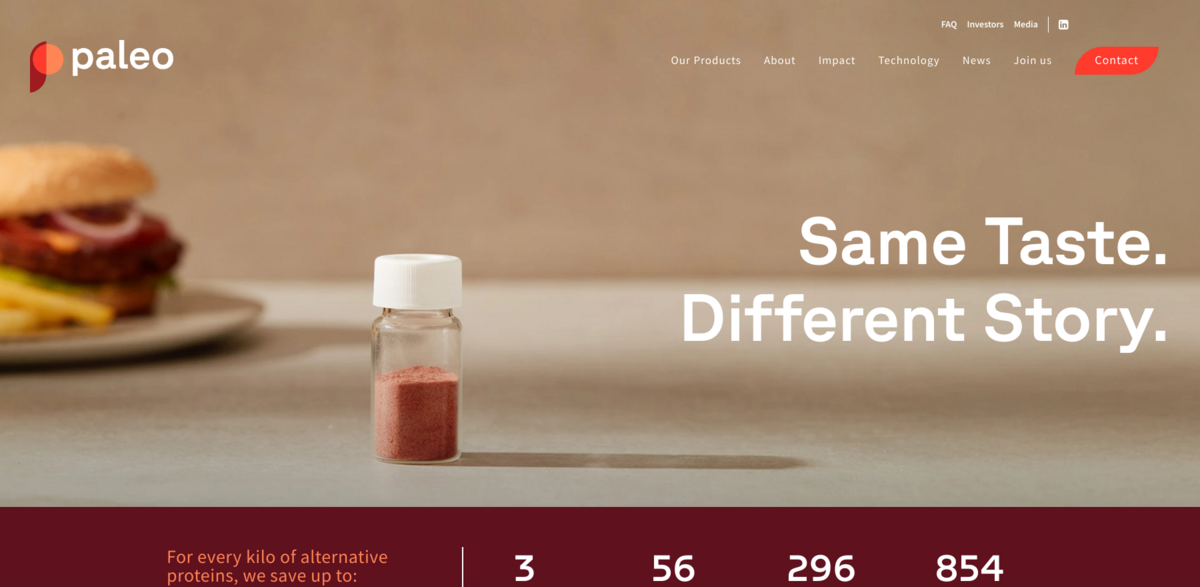What Is the Paleo Project All About?
Meet Paleo — a bold, innovative venture rewriting the story of meat. Instead of raising animals, Paleo uses precision fermentation to brew animal proteins with yeast. By introducing a snippet of DNA into yeast cells, they get the yeast to produce myoglobin, a key protein that makes meat and fish alternatives taste, smell, and look just like the real thing. It’s a game-changer for anyone who loves the flavor of meat but wants a more sustainable option. Their story might be different, but the taste? Spot on.
The Main Benefit: Sustainability at Its Core
For every kilo of alternative proteins Paleo produces, the environmental savings are impressive:
- 3 individual animals spared
- 56 cubic meters of water saved
- 296 kilograms of CO2-equivalent emissions avoided
- 854 m²a (area time) in land demand reduced
These numbers show just how much impact Paleo’s approach can have — cutting back on land, water, and carbon footprints while protecting biodiversity. It’s sustainability that tastes great.
How Does Paleo Make This Happen?
Precision fermentation is the secret sauce. Paleo instructs yeast cells to produce animal proteins by inserting specific DNA sequences. This process doesn’t require breeding, transporting, or slaughtering livestock. Instead, it’s a clean, efficient way to create bio-identical proteins that are nutritionally and sensorially identical to those found in meat. The result? Authentic meat flavor without the environmental baggage.
Why Paleo’s Myoglobin Matters
Myoglobin is the magic ingredient that gives meat its characteristic taste, smell, and color. Paleo’s production of this protein means plant-based alternatives can finally overcome the taste barrier that’s held them back. It’s not just about sustainability — it’s about delivering an experience that meat lovers will genuinely enjoy. This innovation bridges the gap between environmental responsibility and culinary satisfaction.
Meet the Minds Behind Paleo
The leadership team driving Paleo forward includes:
- Hermes Sanctorum (PhD) – Chief Executive Officer
- Pierre Donck – Chief Business Officer
- Ben Souffriau – Chief Innovation Officer
Supporting them is a strong board featuring industry experts and co-founders like Andy de Jong (MD, MBA). Together, they’re steering Paleo toward a future where meat alternatives don’t just compete — they lead.
Paleo’s Impact on Global Goals
- SDG 2: Zero Hunger — providing sustainable protein sources
- SDG 6: Clean Water and Sanitation — reducing water use drastically
- SDG 12: Responsible Consumption and Production — innovating sustainable food systems
- SDG 13: Climate Action — cutting greenhouse gas emissions
- SDG 15: Life on Land — protecting biodiversity by reducing livestock farming
Who’s Partnering with Paleo?
Paleo collaborates with a wide range of partners to amplify its impact. These include Proteinn Club, Provincie, TPC, Leuven Mindgate, Flanders’ Food, FIT, Flanders Bio, EAPF, Next Food Chain, VLAIO, and Foodvalley. Plus, the project is co-funded by the European Union, highlighting its importance and potential on a continental scale. Together, these partnerships help Paleo push the boundaries of sustainable food innovation.





















